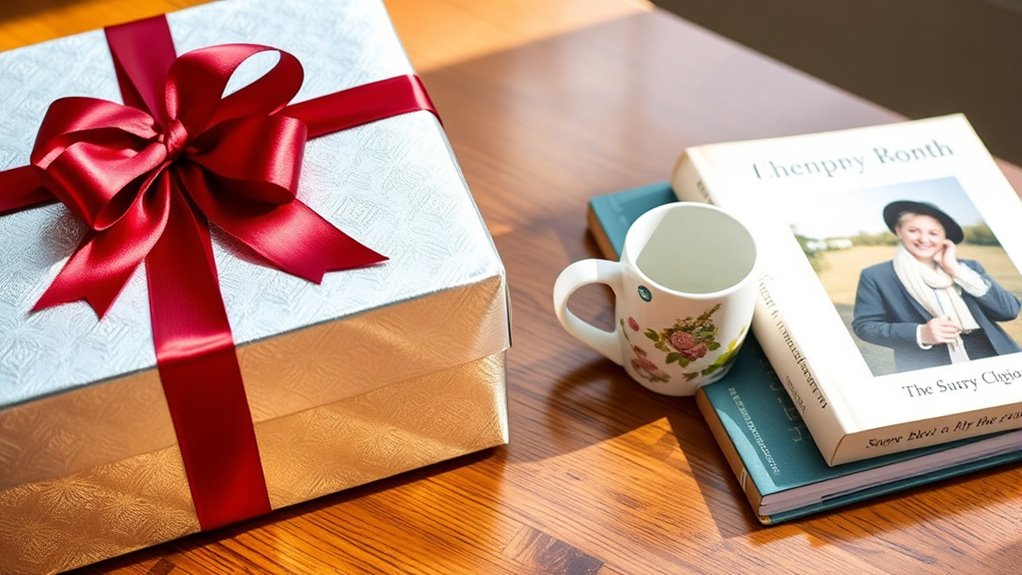When considering regifting, only do so with unused, appropriate items that match the recipient’s tastes and needs. Keep gifts in excellent condition, neatly wrapped, and present them discreetly to avoid awkwardness. Avoid regifting to the original giver or sentimental items that may offend. Think about how the recipient will perceive the gift and choose something thoughtful. To discover more about proper regifting etiquette and make sure you do it right, keep going.
Key Takeaways
- Only regift unused, suitable items in excellent condition, ensuring they match the recipient’s preferences and needs.
- Avoid regifting to the original giver or the same person to prevent trust issues and misunderstandings.
- Present the gift discreetly and thoughtfully, using attractive wrapping and personal notes to enhance the gesture.
- Refrain from regifting sentimental or personal items that could offend or hurt the recipient.
- Include a gift receipt if possible, and consider practicality and appropriateness to show respect for the recipient.
Recognize When Regifting Is Appropriate

Knowing when regifting is appropriate can help you avoid awkward situations and keep relationships intact. It’s essential to understand gift card etiquette—only regift gift cards if they are unused, valid, and suitable for the recipient’s preferences. If you’re unsure whether a gift is appropriate to pass on, consider whether it aligns with their taste or needs. Avoid regifting items that could be considered personal or sentimental, as this might offend the recipient. Recognize regifting is not always suitable, especially if it could be seen as a sign of neglect or insincerity. Be aware of common regifting etiquette mistakes, such as giving a gift that hints it was meant for someone else or forgetting to remove original tags. When in doubt, a thoughtful gesture often beats regifting hastily. Additionally, understanding vetted products can help you choose appropriate gifts and avoid potential pitfalls in the regifting process. Proper gift presentation can also make even regifted items feel more thoughtful and considerate, enhancing the recipient’s experience.
Keep the Gift in Excellent Condition

To guarantee your regifted item leaves a positive impression, it’s crucial to keep it in excellent condition. Ensure the gift looks fresh and unused by inspecting it thoroughly. Clean or polish items if needed, and replace any damaged packaging. Good gift presentation starts with neat gift wrapping; a tidy, attractive wrap enhances the overall impression. Avoid wrinkled or torn wrapping paper, and add a ribbon or bow for a polished look. Consider including a handwritten note for a personal touch. Here’s a quick guide:
| Aspect | Tips |
|---|---|
| Cleanliness | Wipe or polish as needed |
| Packaging | Use fresh, undamaged wrapping |
| Presentation | Add ribbons or bows |
| Personal Touch | Include a handwritten note |
| Overall Impression | Ensure it looks thoughtful and new |
Additionally, paying attention to presentation quality can significantly elevate the perceived value of your regift. Ensuring the condition of the gift remains excellent is essential for maintaining its appeal and avoids awkwardness or disappointment. Maintaining the support hours of the original gift, such as ensuring electronics are functional or tickets are valid, can also help uphold a positive experience. Regularly verifying that the materials of the gift are in good shape can prevent issues upon gifting. Furthermore, considering environmental considerations helps ensure your regifting practices support sustainability and respect for nature.
Avoid Regifting Personal or Sentimental Items

While keeping a gift in excellent condition guarantees it makes a good impression, it’s equally important to avoid regifting items with sentimental value. Personal or sentimental items carry emotional attachments that can make the recipient feel uncomfortable or offend the original giver. Regifting such items shows a lack of respect for the sentimental significance and can suggest a disregard for the personal attachment involved. If you receive something meaningful, it’s best to keep it or thoughtfully pass it on to someone who will truly appreciate its value. Avoid the temptation to rehome sentimental items, as doing so can damage trust and lead to misunderstandings. Respect the emotional significance behind these gifts, and when in doubt, choose something more neutral to regift. **Understanding the importance of emotional attachments can help you navigate regifting etiquette more thoughtfully, especially considering **allergy risks related to certain items. Being aware of AI’s impact on privacy can also remind us to handle personal items with sensitivity and discretion. Recognizing cultural differences in gift-giving can further enhance your approach to regifting appropriately. Additionally, being aware of WWE Raw’s financial impact highlights the importance of respecting the value and significance of gifts, whether personal or commercial, in different contexts.
Be Discreet and Respectful When Giving the Gift

When giving a gift, it’s important to be discreet and respectful to make certain the recipient feels comfortable and appreciated. Keep gift card etiquette in mind by presenting it thoughtfully—avoid flashing it openly or making a big deal. Consider wrapping considerations; a nicely wrapped gift shows effort and respect, even for simple items. Be mindful of the setting and timing, ensuring privacy during the exchange. For example, you might discreetly hand over the gift, avoiding drawing attention. Remember, your goal is to make the recipient feel valued, not embarrassed. Being aware of bedroom decor preferences can help ensure your gesture aligns with their personal style and comfort. Additionally, understanding city dynamics can guide you in choosing appropriate moments and locations for gift exchanges, especially in a bustling environment. Recognizing the importance of AI security in protecting sensitive information can also inform how you handle personal data during gift transactions. Paying attention to cultural sensitivities can help you avoid misunderstandings and show respect for different traditions and customs. Being mindful of emotional reactions is also crucial, as some recipients may have complex feelings about regifting or receiving gifts. Use the table below to guide your presentation:
| Aspect | Tip | Why |
|---|---|---|
| Gift Card Etiquette | Present with a card or note for personal touch | Adds thoughtfulness |
| Wrapping Considerations | Use elegant, neutral wrapping | Shows respect and effort |
| Delivery Method | Hand over privately rather than openly | Maintains discretion |
Do Not Regift to the Original Sender

Regifting an item back to the original sender can create confusion or hurt feelings, even if unintended. It also risks damaging trust and your reputation if they discover the gift has been passed along. To avoid these issues, it’s best to keep the original gift separate and not re-present it to the person who gave it to you. Additionally, understanding best regifting practices can help you navigate gift exchanges more thoughtfully. Being aware of gift etiquette ensures respectful and considerate interactions during the holiday season and beyond. Recognizing appropriate regifting situations can further help you make thoughtful decisions about when and how to re-gift. Being mindful of social expectations can help prevent misunderstandings and maintain positive relationships. Considering personal boundaries and the context of the gift can also guide appropriate regifting choices.
Avoid Familiarity Risks
Regifting to the original sender can create uncomfortable situations or damage relationships if they recognize their gift. To avoid this, steer clear of regifting to the person who gave you the gift. Even if it’s wrapped nicely, they might notice signs of reuse or familiarity. Always consider proper gift wrapping and follow gift card etiquette—avoid reusing cards or giving them back to the same person.
| Situation | Potential Issue | Solution |
|---|---|---|
| Rewrapping a gift | Sender recognizes wrapping style | Use neutral wrapping or new paper |
| Gift card reuse | Sender remembers previous card | Give a new gift card or cash |
| Same person as recipient | Person notices familiarity | Choose a different recipient |
Sticking to these guidelines keeps your regifting thoughtful and avoids awkwardness.
Prevent Confusion or Offense
Re-gifting the same item back to the person who originally gave it to you can lead to confusion or unintended offense. It may suggest you didn’t appreciate their gesture or, worse, imply insincerity. To avoid misunderstandings, consider cultural sensitivities that might make re-gifting inappropriate or disrespectful. Also, be aware of legal considerations, such as warranties or personalized items that may not be suitable for re-gifting.
- Avoid re-gifting to the original sender to prevent confusion
- Be mindful of cultural sensitivities around gift exchanges
- Consider legal considerations like warranties or personalized items
- Think about whether the gift might be misunderstood or offend
- Ensure the gift’s origin is clear to avoid awkward situations
Maintain Trust and Integrity
To maintain trust and uphold your integrity, it’s best to avoid giving a gift back to the person who originally gave it to you. Regifting to the sender can easily damage relationships and breach trust. When considering gift card etiquette, think carefully before passing along a gift card to the same person, as it may seem unthoughtful or suspicious. Following regifting etiquette tips, always ensure the gift is appropriate and unused, but never return it to the original giver. Doing so can create misunderstandings or hurt feelings. Instead, focus on finding a new recipient who will appreciate the gift genuinely. Respecting this boundary preserves your honesty and shows respect for their kindness, reinforcing your integrity and maintaining healthy relationships.
Think About the Recipient’s Preferences

When regifting, it’s essential to contemplate what the recipient actually likes and needs. Think about their personal tastes and hobbies to choose something they’ll appreciate. Practical items that suit their lifestyle show thoughtfulness and increase the chances they’ll genuinely enjoy the gift.
Know Personal Tastes
Since you want your gift to be genuinely appreciated, it’s important to contemplate the recipient’s personal tastes. Think about their hobbies, favorite colors, and style preferences. When regifting, keep these in mind to avoid giving something they wouldn’t enjoy. Consider how they might prefer to receive the gift—some might appreciate thoughtful gift wrapping, while others prefer simple packaging. Always include a gift receipt; it allows them to exchange or choose something more suited to their tastes without discomfort. Avoid giving items that clash with their personality or existing belongings. By paying attention to what they like, you show thoughtfulness and respect, making the regift more meaningful and appreciated.
- Favorite colors or themes
- Personal hobbies or interests
- Preferred brands or styles
- Allergies or sensitivities
- Gift wrapping preferences
Consider Practical Use
Considering how your recipient might actually use the gift can make all the difference in ensuring it’s appreciated. Think about their lifestyle and preferences, and choose something practical that fits their needs. When regifting, consider adding creative packaging to make the gift feel special, even if it’s reused. A personalized note can also add a thoughtful touch, showing you put effort into the gesture. this demonstrates that you respect their tastes and preferences, making the gift more meaningful. Avoid regifting items that might be inconvenient or unwanted; instead, focus on practical, useful presents that suit their daily routines. By paying attention to what they truly need or want, you elevate the regifting experience and maintain good etiquette.
When in Doubt, Give a Thoughtful Alternative

If you’re unsure whether to regift, opting for a thoughtful alternative can prevent awkwardness and show you care. Instead of regifting, consider personalized options like handwritten notes, homemade treats, or a meaningful book. These gestures often feel more sincere and avoid the pitfalls of gift card etiquette, which can seem impersonal if not done thoughtfully. When giving a gift card, pay attention to wrapping considerations—use attractive, well-presented packaging to add a personal touch. You might also include a small note explaining why you chose this gift. This approach shows effort and thoughtfulness, making the recipient feel appreciated. When in doubt, these alternatives demonstrate genuine kindness and ensure your gesture is both respectful and meaningful.
Frequently Asked Questions
Can Regifting Be Appropriate for Holiday or Special Occasion Presents?
You might wonder if regifting is appropriate for holiday or special occasion presents. Regarding holiday appropriateness, it can be acceptable if you’re thoughtful and transparent. For special occasion etiquette, make sure the gift is in excellent condition and suits the recipient’s taste. Regifting can be a considerate way to reuse items, but avoid it if there’s a risk of awkwardness or if it could seem inconsiderate.
How Should I Handle a Regift That Is Slightly Damaged?
Imagine gently restoring a treasured picture frame; you can do the same with a slightly damaged gift. Carefully inspect for damage, then use discreet damage concealment techniques, like wrapping or adding decorative touches, to hide imperfections. Focus on presentation improvement to make it feel fresh and thoughtful. Remember, your goal is to make the gift look as appealing as possible, showing care and effort despite any flaws.
Is It Acceptable to Regift Items Purchased From Discount Stores?
You might wonder if regifting items from discount stores is acceptable. While discount store ethics can be tricky, it’s generally fine if the item is in good condition and you’re thoughtful about the regifting value. Make sure the recipient will appreciate the gift, and avoid regifting something that might seem impersonal or cheap. When done thoughtfully, regifting from discount stores can be a considerate gesture.
Should I Include a Gift Receipt When Regifting?
Oh, the thrill of regifting with a gift receipt! You get to pretend you put thought into gift presentation while secretly planning to return it. Including a gift receipt is a smart move; it shows honesty and makes the recipient’s life easier. They can exchange or return if needed, no awkward confrontations. So yes, always slip in that gift receipt—your secret weapon for smooth regifting!
How Do I Politely Decline a Regift if I Find It Inappropriate?
When you find a regift inappropriate, it’s important to respect your personal boundaries while acknowledging cultural differences. You can politely decline by expressing gratitude and honestly saying you don’t feel comfortable accepting it. For example, you might say, “Thanks so much, but I prefer not to accept this,” or, “I appreciate it, but I’ll pass on regifting.” Maintaining politeness helps navigate differing cultural norms gracefully.
Conclusion
By following these guidelines, you’ll avoid stepping on toes and keep your reputation intact. Regifting can be a thoughtful gesture if done right, but it’s easy to fall into pitfalls. Remember, it’s better to give something meaningful than just to pass along clutter. When you handle regifting with care and respect, everyone benefits—yourself included. After all, it’s not about the gift, but the thought behind it that counts.









